牛津译林版1B英语一年级下教案和习题及答案【全册教案】
- 格式:pdf
- 大小:7.90 MB
- 文档页数:155
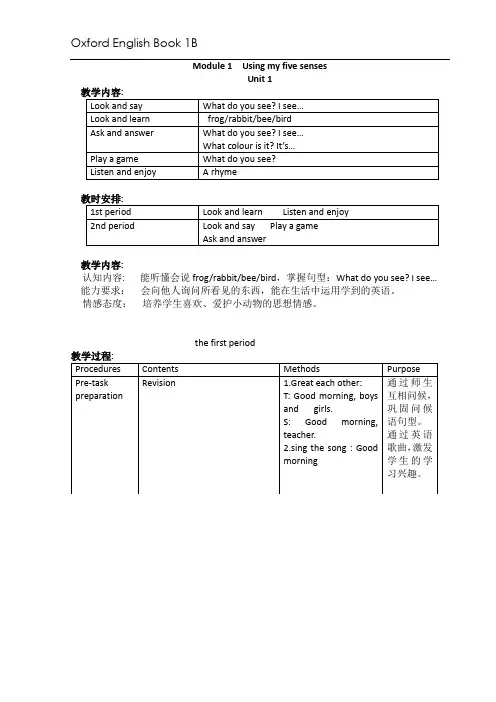
Module 1 Using my five sensesUnit 1教学内容:认知内容: 能听懂会说frog/rabbit/bee/bird,掌握句型:What do you see? I see…能力要求:会向他人询问所看见的东西,能在生活中运用学到的英语。
情感态度:培养学生喜欢、爱护小动物的思想情感。
the first periodModule 1 Unit 2 Listen and hearI.知识点●Daily expressions: What do yo u hear?I hear…What can you hear?I can hear…●Vocabulary: sheep hen dog cat●Text types: song, game, conversation, storyII. 课时安排●Period 1: a. Look and learn: sheep hen dog catListen and say: What do you hear?I hear…b. Play a game●Period 2: a. Look and say: What do you hear? I hear…What can you hear? I can hear…b. Say and act : a short dialogue ‘At home’c. Make a short dialogue.d. sing a song “Bingo”III. The contentsWords: sheep hen dog catSkills: What do you hear? I hear…IV. 能力要求学生学会用句型What do you hear?进行讯问。
会用I hear..来回答V. 情感态度学生在游戏和表演中学习新的知识, 并通过游戏和表演来巩固新知识,创设良好的活动氛围, 让学生带着愉快的心情去迎接新的挑战.Module1 Using my five sensesUnit 3 Taste and smell教学内容:The first period教学内容:认知内容:1. 能听懂并会说rice,soup,egg,noodles2.能够用祈使句来请别人闻一闻,尝一尝能力要求:能够在食物方面表达自己的喜好情感态度:培养学生在生活中运用英语的能力教学过程:The second period教学内容:认知内容: 1. 熟练使用祈使句:stand up, touch your nose.Smell the flower.2. 能认读listen and enjoy能力要求:能够背诵儿歌,并能熟练运用祈使句情感态度:能用How many..?的句型问答身边事物的数量教学过程:Module 1 Unit 3 Taste and smell (一)教学目标(二)划分课时Homework: 1. read SB P10, 13.2. Tell your parents which foods or fruits smell nice, or taste yummy.第二课时(2nd PERIOD)Homework: 1. read SB P11,12.2. students practice the dialogue in groups after class.Module 2 My favourite thingsUnit 1 Toys I likethe first period教学内容:认知内容: 能听懂会说ball/doll/bicycle/kite; 掌握句型I like the …/What do you like?I like…能力要求:会用英语与他人交流彼此的喜好情感态度:玩具是孩子们的好朋友, 注意引导孩子爱护玩具,懂得与朋友分享the second period教学内容:认知内容: 1. 能听懂会说super/nice等形容词2. 正确理解I like the…和I like my …句型3. 掌握What do you like? I like …句型能力要求: 1. 会用简单的英语与营业员交流2. 会表达自己的喜好并简单说明原因情感态度:鼓励孩子用英语在公共场合与他人进行交流, 如商店等。
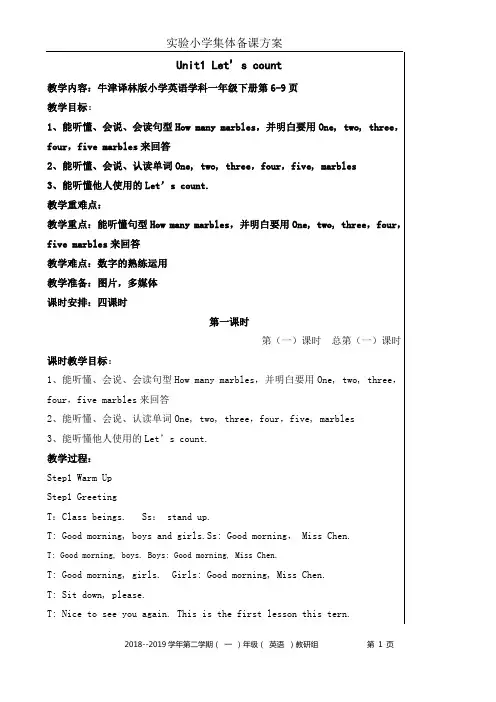
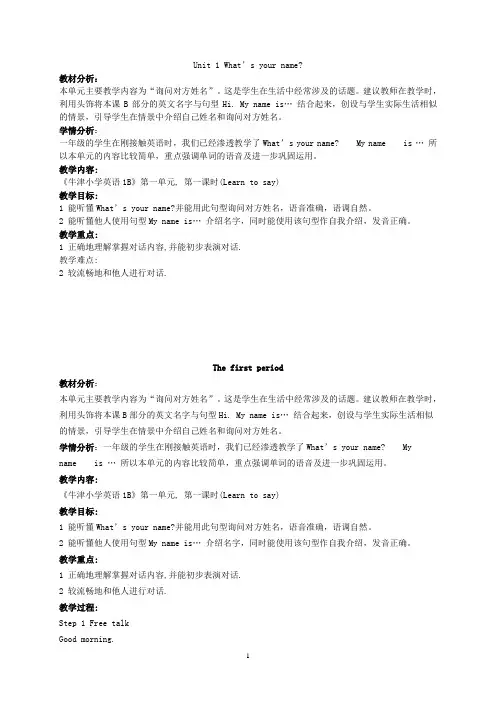
Unit 1 What’s your name?教材分析:本单元主要教学内容为“询问对方姓名”。
这是学生在生活中经常涉及的话题。
建议教师在教学时,利用头饰将本课B部分的英文名字与句型Hi. My name is… 结合起来,创设与学生实际生活相似的情景,引导学生在情景中介绍自己姓名和询问对方姓名。
学情分析:一年级的学生在刚接触英语时,我们已经渗透教学了What’s your name? My name is … 所以本单元的内容比较简单,重点强调单词的语音及进一步巩固运用。
教学内容:《牛津小学英语1B》第一单元, 第一课时(Learn to say)教学目标:1 能听懂What’s your name?并能用此句型询问对方姓名,语音准确,语调自然。
2 能听懂他人使用句型My name is… 介绍名字,同时能使用该句型作自我介绍,发音正确。
教学重点:1 正确地理解掌握对话内容,并能初步表演对话.教学难点:2 较流畅地和他人进行对话.The first period教材分析:本单元主要教学内容为“询问对方姓名”。
这是学生在生活中经常涉及的话题。
建议教师在教学时,利用头饰将本课B部分的英文名字与句型Hi. My name is… 结合起来,创设与学生实际生活相似的情景,引导学生在情景中介绍自己姓名和询问对方姓名。
学情分析:一年级的学生在刚接触英语时,我们已经渗透教学了What’s your name? My name is … 所以本单元的内容比较简单,重点强调单词的语音及进一步巩固运用。
教学内容:《牛津小学英语1B》第一单元, 第一课时(Learn to say)教学目标:1 能听懂What’s your name?并能用此句型询问对方姓名,语音准确,语调自然。
2 能听懂他人使用句型My name is… 介绍名字,同时能使用该句型作自我介绍,发音正确。
教学重点:1 正确地理解掌握对话内容,并能初步表演对话.2 较流畅地和他人进行对话.教学过程:Step 1 Free talkHappy new year! Boys and girls.Step 2 Listen and doStand up, please. / Sit down, please.Show me your nose/ears/eyes…Step 3 Presentation1 建议教师向全班学生打招呼说Hello! Class. I’m … Myname is… 边说边指指自己的胸牌(直接切入主题),然后与个别学生打招呼。
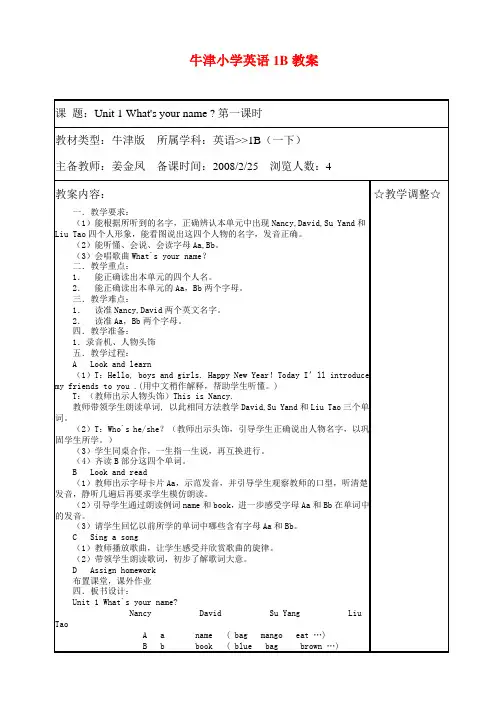
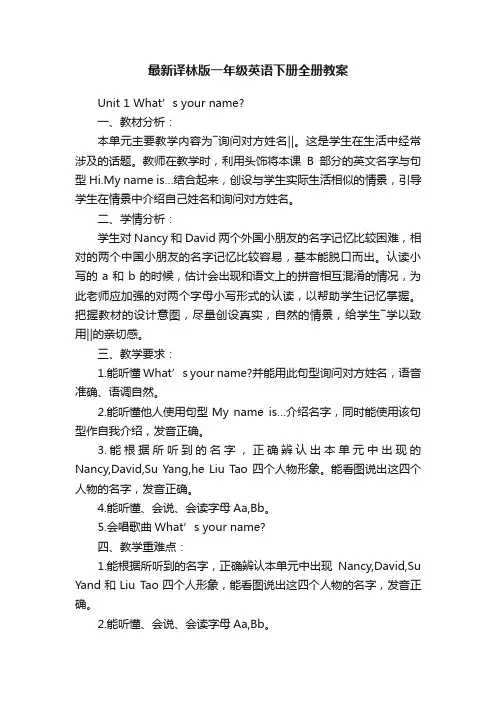
最新译林版一年级英语下册全册教案Unit 1 What’s your name?一、教材分析:本单元主要教学内容为―询问对方姓名‖。
这是学生在生活中经常涉及的话题。
教师在教学时,利用头饰将本课B部分的英文名字与句型Hi.My name is…结合起来,创设与学生实际生活相似的情景,引导学生在情景中介绍自己姓名和询问对方姓名。
二、学情分析:学生对Nancy和David两个外国小朋友的名字记忆比较困难,相对的两个中国小朋友的名字记忆比较容易,基本能脱口而出。
认读小写的a和b的时候,估计会出现和语文上的拼音相互混淆的情况,为此老师应加强的对两个字母小写形式的认读,以帮助学生记忆掌握。
把握教材的设计意图,尽量创设真实,自然的情景,给学生―学以致用‖的亲切感。
三、教学要求:1.能听懂What’s your name?并能用此句型询问对方姓名,语音准确、语调自然。
2.能听懂他人使用句型My name is…介绍名字,同时能使用该句型作自我介绍,发音正确。
3.能根据所听到的名字,正确辨认出本单元中出现的Nancy,David,Su Yang,he Liu Tao 四个人物形象。
能看图说出这四个人物的名字,发音正确。
4.能听懂、会说、会读字母Aa,Bb。
5.会唱歌曲What’s your name?四、教学重难点:1.能根据所听到的名字,正确辨认本单元中出现Nancy,David,Su Yand和Liu Tao四个人形象,能看图说出这四个人物的名字,发音正确。
2.能听懂、会说、会读字母Aa,Bb。
五、课时安排:四课时第一课时教学内容:Fun with English 1 B A Learn to say教学目标:1.Help students review how to tell their names with the pattern: I’m… and teach the pattern of asking names: What’s your name? And answered: My name is…2. Review the boy, Mike. And introduce a boy named David.3.Stimulate students’ interests in studying English.教学重点、难点:1.Make sure that students can tell their names with the pattern: My name is… Help students to ask and to answer:―What’s your name?‖and use either ―My name is…‖or ―I’m…‖toanswer this question.2.Make sure that students can make the difference between Mike and David. And they enable to read ―David‖ correctly.3. Ss can ask and answer freely.教学准备:Pictures教学过程:Step 1:warming-upT: Good morning, boys and girls. I’m your new English teacher. I’m Miss Fang. Ss: Good morning. Ss:Miss Fang. Ss:sing a song .T:I’m very happy to see you. Ss: Happy.T:How are you? Ss: Fine thank you.T: Welcome back to school. Ss: Thank you. Happy New Year!Play a game: Follow me.Step 2: presentation1.T puts on the headwear and pretends to be some lovely animals, then T says hello to theSs.S1: Hello, …!S2: Hello, …!S3: Hello, …!S4: Hello, …!S5: Hello, ….!2.T: Hi, boys and girls. I’m your old friend, My name is Mike. Mike Mike my name isMike.Ss look at the blackboard.Ss read: MikeSs look at T’s mouth and read.T writes down: My name is… on the blackboardT: Now you’re all Mike.Ss read after me : Mike Mike my name is Mike.3.T takes off the headwear, Vivian, vivian, My name is vivian. Hi,what’s your name?Ss read after me : Vivian, vivian, My name is vivian.Ss : Mike Mike my name is Mike.T: Yes,when someone ask your name, you can answer: my name is… (point to the blackboard) And you also can say: I’m …, we have learnt this sentence last term.Ss look at the blackboard.Ss look at T’s mouth and read.Ss read after me : My name is ….S1: Hi,My name is… (If Ss don’t say ―hello‖ or ―Hi‖, T gives them hint)S2: Hello, I’m…Ss look at the blackboard.Ss look at my mouth, read after meSs read after me: name, your name, my nameT: Hi, w hat’s your name? (T writes on the blackboard) T emphasizes the pronounce of ―your name‖ and make the difference between ―my name‖ by the gesture.Chain workChain work: Hi,what’s your name? Hello, my name is… . Have a group competition.Make frie nds:Ss follow T say What’s your name?‖several times. T asks Ss to find a classmate and to make friends mutually. (What’s your name? My name is…)Make friendsSs look at the teacher.Look at my mouth, then read after me.Read it as the little train, go go go.4.T: Let me introduce a new friend to you. T shows the picture of David.T: Oh, My name is David. David David. (Write down on the blackboard.)T corrects the pronunciations.T: Do you want to be my friend?T: smile, Hello, What’s your name?s: Yes.S1: I’m S1. (practice with some Ss)S2: I’m S2.S3: I’m S3.S4: I’m S4.S4: I’m S5.5. T: Daivd and Mike are our new classmates (explainclassmates) And they’re all English Boys, can you find any difference between them?. Teacher concluded. Ss answer Play a game: left & right.Chain work: Hi,what’s your name? Hello, my name is… . Have a group competition.Make friends:Ss follow T say What’s your name?‖several times. T asks Ss to find a classmate and to make friends mutually. (What’s your name? My name is…)Ss look at the teacher.Look at my mouth, then read after me.Read it as the little train, go go go.s: Yes.S1: I’m S1. (practice with some Ss)S2: I’m S2.S3: I’m S3.S4: I’m S4.S4: I’m S5.Ss answerPlay a game: left & right.Step 3 practice.Open the books and read after the tape recorder together.Read after teacher together.Read as different characters.Read by themselves.( in pairs)Ss put on the headgear and make dialogues with others.Step 4: ConclusionEvaluate students’ performance and give hom ework.Step 5: Homework:Review Part A of this unit.板书设计:Unit 1 What’s your name?Hello! Hi! What’s your name?Hello! Hi! My name is ….MikeI’m…David.教学后记:第二课时教学内容:Fun with English 1 B B. Look and learn & D. Sing a song教学目标:1. To present students the three names of the children and make sure they know how to read: Nancy, Su Yang, Liu Tao.2. Review the sentences: Hello! Hi! What’s your name?Hello! Hi! My name is ….。
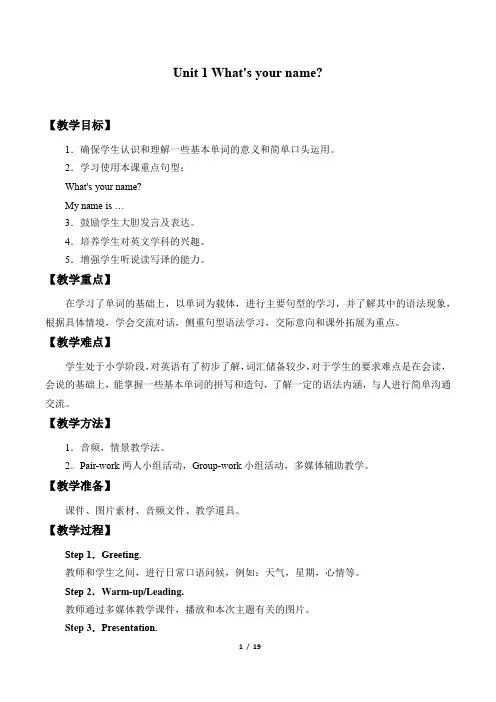
Unit 1 What's your name?【教学目标】1.确保学生认识和理解一些基本单词的意义和简单口头运用。
2.学习使用本课重点句型:What's your name?My name is …3.鼓励学生大胆发言及表达。
4.培养学生对英文学科的兴趣。
5.增强学生听说读写译的能力。
【教学重点】在学习了单词的基础上,以单词为载体,进行主要句型的学习,并了解其中的语法现象,根据具体情境,学会交流对话,侧重句型语法学习,交际意向和课外拓展为重点。
【教学难点】学生处于小学阶段,对英语有了初步了解,词汇储备较少,对于学生的要求难点是在会读,会说的基础上,能掌握一些基本单词的拼写和造句,了解一定的语法内涵,与人进行简单沟通交流。
【教学方法】1.音频,情景教学法。
2.Pair-work两人小组活动,Group-work小组活动,多媒体辅助教学。
【教学准备】课件、图片素材、音频文件、教学道具。
【教学过程】Step 1.Greeting.教师和学生之间,进行日常口语问候,例如:天气,星期,心情等。
Step 2.Warm-up/Leading.教师通过多媒体教学课件,播放和本次主题有关的图片。
Step 3.Presentation.1.Words Learning.(1)老师放映课件,用中文询问同学看到了什么?同学们会看到课件上呈现的图画。
(2)教师拿出单词卡片,进入重点新词汇学习环节,向同学展示图片,结合PPT上放映的内容,带领同学学习一些新单词。
2.Pronunciation Part.(1)老师介绍本课重点单词读音及重点音标,带领同学大声朗读。
(2)然后老师带领同学进行拓展学习,介绍一些该音标构成的其他单词。
3.Listening Part.Have the Ss listen and repeat.4.Reading Part.(1)教师立足于课本,引导学生学习课本上的对话。
(2)教师向同学解释课文内容,并让学生反复听读,学习模仿。
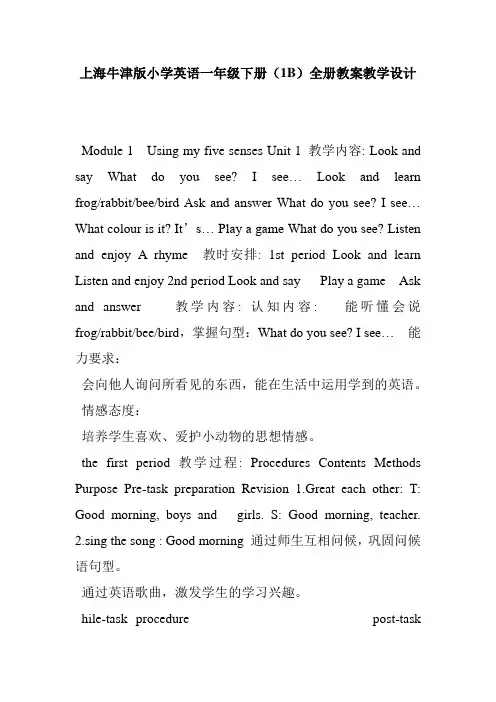
上海牛津版小学英语一年级下册(1B)全册教案教学设计Module 1 Using my five senses Unit 1 教学内容: Look and say What do you see? I see… Look and learn frog/rabbit/bee/bird Ask and answer What do you see? I see… What colour is it? It’s… Play a game What do you see? Listen and enjoy A rhyme 教时安排: 1st period Look and learn Listen and enjoy 2nd period Look and say Play a game Ask and answer教学内容: 认知内容: 能听懂会说frog/rabbit/bee/bird,掌握句型:What do you see? I see… 能力要求:会向他人询问所看见的东西,能在生活中运用学到的英语。
情感态度:培养学生喜欢、爱护小动物的思想情感。
the first period 教学过程: Procedures Contents Methods Purpose Pre-task preparation Revision 1.Great each other: T: Good morning, boys and girls. S: Good morning, teacher.2.sing the song : Good morning 通过师生互相问候,巩固问候语句型。
通过英语歌曲,激发学生的学习兴趣。
hile-task procedure post-taskactivity Assignment Review the words: panda/bear/tigerl/monkey 1. Presentation 2. Practice Learn the new words frog/rabbit/bee/bird Game A rhyme : Presentation Review the rhyme Let the students play a guessing game. T: It’s fat.It’s black and white.what is it? 1. Say after the teacher 2. Say together 3. ask and answer in pairs. 4. say and act in pairs. T:We have many new friends, let’s see what are they? 1. Read after the teacher 2. read it one by one. 3. read it in high voice in low voice. 4. Who can be little teacher?Play a guessing game. Hold the word cards on the teacher’s hand. The students can’t see the words. Then get them guess. If he is right, he can get a gift. One,two,three, I am a bee. Four,five, I am a bird. Six,seven,eight, I am a rabbit Nine,ten, I am a frog. Ask the students to say after the teacher. 1. ask the students to say and act it in pairs. 2. ask some students to say and act in front of the class.Listen to the type Read the new words Recite the new rhyme. 通过做“猜一猜”的游戏,使得学生复习上学期所学的有关动物的单词。
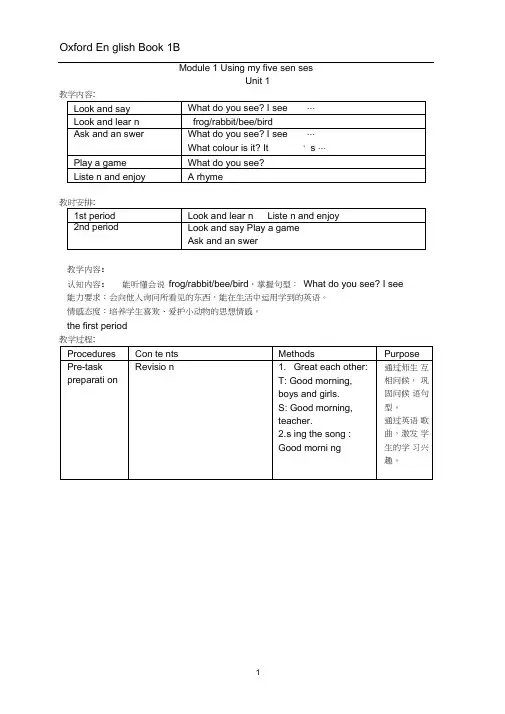
Module 1 Using my five sen sesUnit 1教时安排教学内容:认知内容:能听懂会说frog/rabbit/bee/bird,掌握句型:What do you see? I see 能力要求:会向他人询问所看见的东西,能在生活中运用学到的英语。
情感态度:培养学生喜欢、爱护小动物的思想情感。
the first periodhile-task procedureReview the words:panda/bear/tigerl/mon key1. P rese ntati on2. PracticeLear n the new wordsfrog/rabbit/bee/birdGameLet the stude nts playa guess ing game.T: It 'at.lt blask andwhite.what is it?1. Say after theteacher 2.Say together3. ask and answer inpairs.4. say and act inpairs. T:We have manynew friends, let "seewhat are they?1. Read after theteacher2. read it one by one.3. read it in high voicein low voice.4. Who can be littleteacher?Play a guess inggame. Hold the wordcards on the teacher' hand.The students can'see the words.Then get themguess. If he is right,he can get a gift.On e,two,three,I am a bee.Four,five, I am abird. Six,seve n,eight,I am a rabbitNin e,te n,通过做猜一猜”的游戏,使得学生复习上学期所学的有关动物的单词。
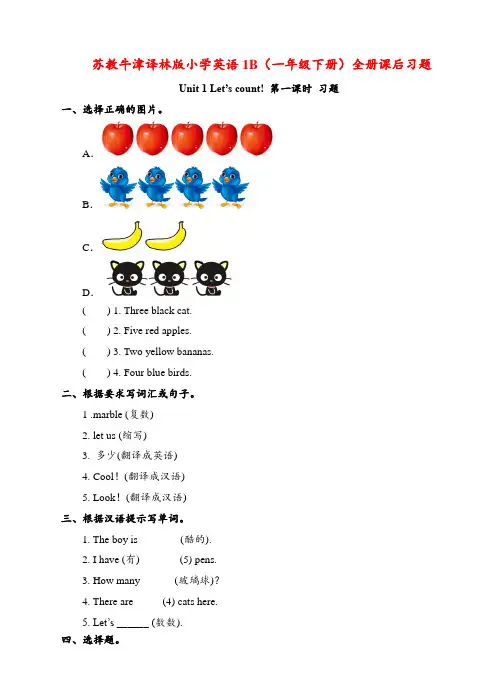
苏教牛津译林版小学英语1B(一年级下册)全册课后习题Unit 1 Let’s count! 第一课时习题一、选择正确的图片。
A.B.C.D.() 1. Three black cat.() 2. Five red apples.() 3. Two yellow bananas.() 4. Four blue birds.二、根据要求写词汇或句子。
1 .marble (复数)____________2. let us (缩写)______________3. 多少(翻译成英语)______________4. Cool!(翻译成汉语) ___________5. Look!(翻译成汉语) ______________三、根据汉语提示写单词。
1. The boy is _______ (酷的).2. I have (有)_______ (5) pens.3. How many______ (玻璃球)?4. There are _____(4) cats here.5. Let’s ______ (数数).四、选择题。
( ) 1. I only (仅仅) have ______ book.A. twoB. oneC. three( ) 2. --__________? --Five.A. How many applesB. What is itC. Who are you( ) 3. How many red _______?A. marbleB. marblesC. water( ) 4. –How many books? --________.A. It’s a bookB. CoolC. Five( ) 5. One and two is ______.A. threeB. fourC. five五、按要求完成句子。
1. how/ red/ many/ marbles (?) (连词成句)___________________________________________2. count/ let’s (.)(连词成句)___________________________________________3. Three red marbles. (提问)_________________________________________4. Let’s count. (翻译成汉语)_________________________________________5. 多少黄色的玻璃球?(翻译成英语)__________________________________________Unit 1 Let’s count! 第一课时答案一、【解析】该题考查数词的识记【答案】1. D 2. A 3. C 4. B二、【解析】1. marble加-s变成复数marbles,故答案为marbles。
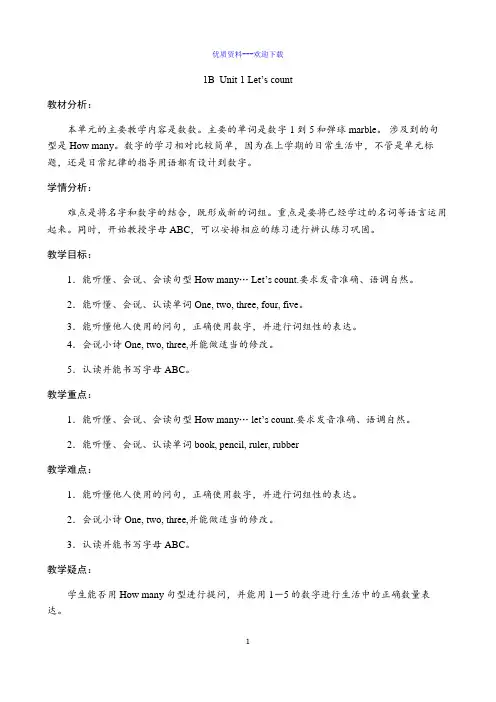
优质资料---欢迎下载1B Unit 1 Let’s count教材分析:本单元的主要教学内容是数数。
主要的单词是数字1到5和弹球marble。
涉及到的句型是How many。
数字的学习相对比较简单,因为在上学期的日常生活中,不管是单元标题,还是日常纪律的指导用语都有设计到数字。
学情分析:难点是将名字和数字的结合,既形成新的词组。
重点是要将已经学过的名词等语言运用起来。
同时,开始教授字母ABC,可以安排相应的练习进行辨认练习巩固。
教学目标:1.能听懂、会说、会读句型How many… Let’s count.要求发音准确、语调自然。
2.能听懂、会说、认读单词One, two, three, four, five。
3.能听懂他人使用的问句,正确使用数字,并进行词组性的表达。
4.会说小诗One, two, three,并能做适当的修改。
5.认读并能书写字母ABC。
教学重点:1.能听懂、会说、会读句型How many… let’s count.要求发音准确、语调自然。
2.能听懂、会说、认读单词book, pencil, ruler, rubber教学难点:1.能听懂他人使用的问句,正确使用数字,并进行词组性的表达。
2.会说小诗One, two, three,并能做适当的修改。
3.认读并能书写字母ABC。
教学疑点:学生能否用How many 句型进行提问,并能用1-5的数字进行生活中的正确数量表达。
课时安排:4课时第一课时教学内容:Story time(1)教学目标:1.能听懂、会说、会读句型How many… Let’s count.要求发音准确、语调自然。
2.能听懂、会说、认读单词One, two, three, four, five3.能听懂他人使用的问句,正确使用数字,并进行词组性的表达。
教学重点:1.能听懂、会说、会读句型How many… Let’s count.要求发音准确、语调自然。
2.能听懂、会说、认读单词One, two, three, four, five教学难点:能听懂他人使用的问句,正确使用数字,并进行词组性的表达。
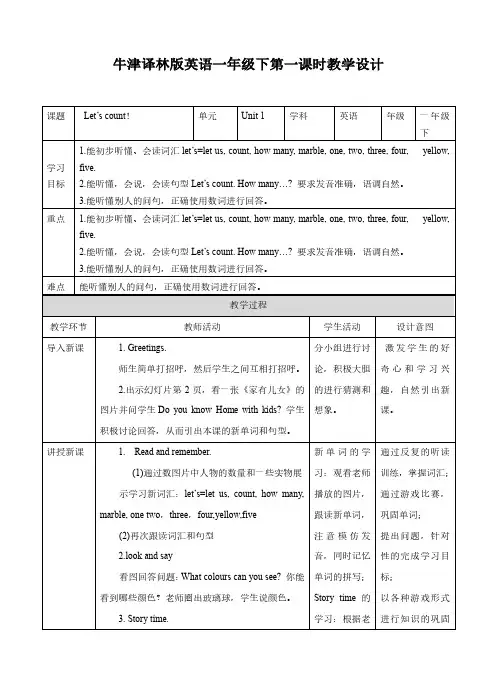
小学英语●课题Unit1 let’s count ●使用1 课时●总第 1 课时●教学目标1、能听懂、会说、会读句型How many marbles,并明白要用One, two, three,four,five marbles 来回答2、能听懂、会说、认读单词One, two, three,four,five, marbles3、能听懂他人使用的let’s count.●教学重点难点教学重点:能听懂句型How many marbles,并明白要用One, two, three,four,five marbles 来回答教学难点:数字的熟练运用●教学具准备及辅助活动图片,多媒体●主要板书计划Unit 1 let’s countHow many marbles?one, two three, four, five●作业设计、安排课内练习How many marbles? one two three four five课外熟练课中所学内容●教学过程教学随笔Step1 Warm UpStep1 GreetingT:Class beings.Ss:stand up.T: Good morning, boys and girls.Ss: Good morning,Miss G.T: Good morning, boys.Boys: Good morning, Miss G.T: Good morning, girls.Girls: Good morning, Miss G.T: sit down, please.T: Nice to see you again. This is the first lesson this tern.let’s enjoy a song first.<Numbers>step 2 presentation1.t: what can you see in this pic? show a marblet:is this a cherry?(no)this is a marble.learn marbleread one by one2. How many marbles?One?Yes.learn one.read one by onelearn one marble.3.t: there is a marble.Now?Here are two marbles.learn marbles4.t: how many marbles?one? two?learn tworead two by twolearn two marbles.5.t: Look at the marbles.How many marbles?let’s count.one, two, three, three marbles. learn threelearn three marbles6.t: how many marbles now? learn how many marbles.read sentences one by one.7.t: who can ask the question? Sn: How many marbles?8. t: let’s count.one, two, three, four.learn fourread one by one.learn four marbles.9.t: how many marbles now? let’s count.learn let’s count.readt: let’s count.who can help me?S1 come and count the numbers for me.t: five.learn five.learn five marbles.step 3 practice1.say the numbersshow the numbers quickly2.say the thingsshow the pics of marbles of different numberst: How many marbles?ss count, and answer.show several pics of different numbers of marbls on them. ss try to make dialogues like:How many marbles?One,two, three, … marbles.小学英语备课用笺●课题Unit1 let’s count ●使用1 课时●总第 2 课时●教学目标1、能听懂、会说、会读句型How many…marbles,并明白要用One, two, three,four,five …marbles来回答2、能听懂、会说、认读单词One, two, three,four,five, marbles3、能认读,听懂他人使用的let’s count4、能听懂、会说单词look,cool●教学重点难点教学重点:1、能听懂、会说、会读句型How many… marbles,并明白要用One, two, three,four,five …marbles来回答2、能听懂、会说、认读单词One, two, three,four,five, marbles教学难点:将对话连贯起来●教学具准备及辅助活动图片,多媒体●主要板书计划Unit 1 let’s countHow many marbles?one, two three, four, five●作业设计、安排课内Pair work课外熟读本节课教授的story time部分●教学过程教学随笔Step1 GreetingT:Class beings.Ss:stand up.T: Good morning, boys and girls.Ss: Good morning,Miss G.T: Good morning, boys.Boys: Good morning, Miss G.T: Good morning, girls.Girls: Good morning, Miss G.T: sit down, please.step 2 presentation1.t: look. this is a box.(Show a box.)(Shake it).There’s something in it.Can you guess?Yes, there are some marbles in it.Look at the marbles.They are different colors.Do you know the color?(red green blue pink)Look, there are red marbles.learn red marblest: Are they nice?Yes, they are cool.learn cool.2.t: do you like red marbles?S1: Yes.t: here you are.then can you tell me: how many red marbles?s1 count.s1 say the numbers.3. t: … red marbles.we also have some?(green marbles)learn green marblest: how many green marbles?ss count.check the answers.4.learn blue marbles and pink marbles.5.show the game on page 8t: here are many things.can you first name them?tell ss how to say bananas, balloons, peaches, robots, boxes, grapes, dogs, cherries, sweaters, teddies, beanies, scarives.show how to play the game firstss play with me.小学英语备课用笺●课题Unit1 let’s count ●使用1 课时●总第 3 课时●教学目标1.巩固上两课所学的单词One two three four five2. 巩固上两课所学的句型let’s count. How many …?3. 学说小诗《one two three》●教学重点难点教学重点:能熟练的说出let’s count. How many …?教学难点:能在语境中自然的运用句型.●教学具准备及辅助活动图片,多媒体●主要板书计划Unit 1 let’s countHow many…?Let’s count.One two three four five marble●作业设计、安排课内同桌对话课外熟读课文,掌握单词和句型.●教学过程教学随笔Step 1 Greeting1. greetingst: Good morning.Ss: Good morning, Miss G.Step 2 practice1.play a game:What can you see?(show some pictures quickly and have a review of the words they havelearned)2.t: Look, what do I have?SS: marbles.T:(抓一把)How many?SS:(guess)T: let’s count. OK?Ss: OK.Count the marbles together.T: Oh, I have three marbles.Are you right?3.play a guessing game with their parters IT:Look at the marbles, S1.Can you guess?S1: guess a number.T: let’s count.Count with all the students.T: yes! / oh, no.Play with S2 again.Ss can play with their partners.4.play a guessing game with their partners IIT:Look at the marbles, S1.How many red/blue/… marbles?S1: guess a number.T: let’s count.Count with all the students.T: yes! / oh, no.Play with S2 again.Ss can play with their partners.5.draw guess and count.T shows a pictures on page 8 but it’s blank.For example, “draw” a peach, and ask students “How many peaches ?”Teach peaches.Ss guess.Show the whole pictures.T: let’s count.One , two, thress. Three peaches.Try another two times.Then ss practice with three partners using the pictures t gives them.T can help them with the pronounciation of nouns.6.T: let’s enjoy a rhyme:<One, two, three>Show the picture.T: what can you see?Learn the two words: tree sticksHow many trees?SS: one.T: what color is it?Ss: green.T: look! A green tree.T: How many sticks? Four? five?Let’s count the sticks. One (ix)Ss: six.Learn six.t: let’s say the ryhme together. T: let’s read after the tape. Pay attention to the tone.小学英语备课用笺●课题Unit1 Let’s count ●使用1 课时●总第 4 课时●教学目标1.复习巩固本单元的单词和句型.2.能改编小诗.3.学习字母.4.完成补充习题及课后习题●教学重点难点教学重点:能在情境中,熟练正确运用句型进行对话教学难点:完成练习册●教学具准备及辅助活动图片,多媒体●主要板书计划Unit 1 let’s countHow many…?Let’s count.One two three four five marble●作业设计、安排课内对话表演完成习题课外运用所学的日常交际用语,朗读课文●教学过程教学随笔Step1 GreetingT:Class beings.Ss:stand up.T: hi, boys and girls.Ss: Hi,Miss G.T: hello, boys.Boys: hello, Miss G.T: hello, girls.Girls: hello, Miss G.T: sit down, please.Step2 review1.show the words quickly, and ss should read them out loudly.2.show some marbles in different color and ss can make dialogues like storytimes.3.read the story time4.say a rhyme <one, two three>Show the picture of this rhyme.T: what can you see?Ss: A green three. Sticks.T: how many sticks?Let’s count the sticks!Ss: one, two (ix)Show the whole rhyme and read it together.5.Change the colour of the tree and the number of the sticks.e.g. a red tree and four sticksT: What can you see?SS: a red tree.T: how many sticks?SS: four.T: Who can make a new rhyme now?Ss try.Change into other colors and numbers.6.learn the letters.Use the picture of the rhyme(two bags under the tree) and show the whole rhyme.T: look, a green three and two bags.Zoom up the letter a and b.Learn Aa and Bb.T: what’s in the bag?Open the bag.T: cherries.Learn the letter Cc.T: good!Learn the letter Dd7.practice the letters.1)Show single letter ,then two together.A cB bc ca …2)Show some words, and ss to find out the letter of ABCD.Bag cherry peach….3)Show some letters in different colour, and try to say phrases like:a green A/ a pink C…4)show a picture with several letters on it, ss should count and make dialogue like:S1: How many red As?S2: One, two... three red As.8.完成补充习题小学英语备课用笺●课题Unit2 This is my pencil. ●使用1 课时●总第 5 课时●教学目标1.能听懂、会说、会读单词pencil 和rubber2.能根据对话的场景正确使用I’m sorry. That’s ok.3.能根据对话的场景,正确提问他人Is this your…? 并作出反应Yes,thank you. 或者No.语音语调正确.●教学重点难点教学重点:1. 能听懂、会说、会读单词pencil 和rubber2.能根据对话的场景正确使用I’m sorry. That’s ok.教学难点:能根据对话的场景,正确提问他人Is this your…? 并作出反应Yes,thank you. 或者No.语音语调正确.●教学具准备及辅助活动图片,多媒体●主要板书计划Unit 2 This is my pencil.pencil rubberI’m sorry.That’s OK.Is this your …Yes, thank you. / No.●作业设计、安排课内对话表演课外朗读课文●教学过程教学随笔Step1 GreetingT:Class beings.Ss:stand up.T: hi, boys and girls.Ss: Hi,Miss G.T: hello, boys.Boys: hello, Miss G.T: hello, girls.Girls: hello, Miss G.T: sit down, please.Step2 presentation1.learn That’s ok.t: (不小心撞在S1身上)Oh, I’m sorry. S1.You can say That’s OK.Try again.Teach That’s.Teach That’s OK.2.learn I’m sorry.T 故意在学生座位间川行,边用I’m sorry.Teach sorry.Teach I’m sorry.3.teach when to use the two sentences.当我们不小心撞到别人时首先要说I’m sorry.对不起表示道歉.此时可以用That’s OK.表示谅解.4.Brain stormT: think about, when can you use the dialogue?请大家一起想想看,生活中有哪些情况是我们可以用到这个对话的?T show some examples.5.try to practice.Ask ss to show when and how can we use the dialogue.6.learn pencilT: (走过时不小心碰到一个学生)oh, I’m sorry, S1.S1: that’s ok.T: oh, look. This is a pencil.Learn pencil.7.learn the sentence.T: Is this your pencil, s1?Yes or no?S1: No.T: is this your pencil?S2: no.T: is this your pencil?S3: no.Teach yourTeach Is this your pencil?Ss read together.Ss read one by one.T: s1, is this your pencil?S1: no.T: can you help ask s2?S1 ask s2.…8.t: whose pencil is this?T: s, is this your pencil.S: Yes.T: you can say Yes, thank you.Learn Yes, thank you.9.practicet: I have another four pencils.I want to find their owners.Let’s find them together, ok?Ss: ok.t-s1: is this your pencil?S1: no.T: can you help me find?S1 can ask anyone in the classroom.T can also show on the ppt, ss can make diagolue with their partners.10.t: I also have something.Look, this is a rubber.Learn rubber.11.practicet: is this your rubber?S1: no.S1: is this your rubber, s2?S2: no.…Show another rubber on the ppt, so ss can practice with their partners.小学英语备课用笺●课题Unit2 This is my pencil. ●使用1 课时●总第 6 课时●教学目标1.能听懂、会说、会读单词book 和ruler2.能根据对话的场景正确使用I’m sorry. That’s ok.3.能根据对话的场景,正确提问他人Is this your…? 并作出反应Yes,thank you. 或者No.语音语调正确.●教学重点难点教学重点:1. 能听懂、会说、会读单词book ruler2.能根据对话的场景正确使用I’m sorry. That’s ok.教学难点:能根据对话的场景,正确提问他人Is this your…? 并作出反应Yes,thank you. 或者No.语音语调正确.●教学具准备及辅助活动图片,多媒体●主要板书计划Unit 2 This is my pencil.pencil rubber ruler bookI’m sorry.That’s OK.Is this your …Yes, thank you. / No.●作业设计、安排课内朗读,模仿story time 部分课外听录音,对话●教学过程教学随笔Step1 GreetingT:Class beings.Ss:stand up.T: Good morning, boys and girls.Ss: Good morning,Miss G.T: Good morning, boys.Boys: Good morning, Miss G.T: Good morning, girls.Girls: Good morning, Miss G.T: sit down, please.Review Good morning.Step 2 presentation1.enjoy a rhyme <one two three>say the rhyme together2.show another pictureT: Now, what’s under the tree?Ss: a bag.T: look, here is the bag.Show a real bag.What’s in the bag?Shake and ss guess.3.show pencil and rubber to have a review.4.go on guessing.Show ruler and bookTeach rulerRead together.Read one by one.Make a phrase: my rulerMake a phrase: your rulerT: what color?Ss: redT: my red ruler.What about your ruler? what colur?S1: greenT: so you can say my green rulerS1:my green ruler.T: we can say your green ruler.T: what about your ruler?You can say?S2:my pink ruler…T: we can say your…5.go on guessingshow bookteach book.Read together.Read one by one.T: who has a book?Show it.Let’s say together: my bookT: point to your partner s’, and you can say?Ss: your book.T: what color is your book?S: …T: you can say my …book.T: we can say your … book. 6.learn story timet:There is a green book.Whose is it?Let’s watch and find out.Watch and find out the answer.7.t: what’s on the floor?Watch again and find out.T: whose pencil?Watch and find out.8.read after the tape.9.try to act out.小学英语备课用笺●课题Unit2 This is my pencil ●使用1 课时●总第7 课时●教学目标1.巩固本单元所学的单词2.能在合适的情境中运用对话3.欣赏并学唱歌曲I am sorry.●教学重点难点教学重点:能听懂、会说book, pencil, ruler, rubber,发音准确.教学难点:能区分单词,特别是和已经学过的单词如bag,读音、认读、会说方面相比较.●教学具准备及辅助活动图片,多媒体●主要板书计划Unit 2 This is my pencil.pencil rubber ruler bookI’m sorry.That’s OK.Is this your …Yes, thank you. / No.●作业设计、安排课内对话表演课外听录音,对话●教学过程教学随笔Step1 Greeting1. T:Class beings.Ss:stand up.T: Good morning, boys and girls.Ss: Good morning,Miss G.T: Good morning, boys.Boys: Good morning, Miss G.T: Good morning, girls.Girls: Good morning, Miss G.T: sit down, please.2.enjoy a song<I am sorry>Step 2 practice1.qucik respondsay as many words as you can:a)水果b)颜色c)文具2.maggic eyes:review the wordsshow the pictures quickly, ss try to read them out3.guess and say Ia)ask four ss come to the teacher’s desk, everyone should bring oneruler/pencil…b)touch one, and ask:t:Is this your …? S1:yes, thank you./No.c)ss do the gourp work4.guess and say IIt collets some rulers/.. before class.T-s1: is this your..? S1:yes, thank you./No.Sn help teacher find the owner.5.play a game:s1 is the seakerget a pencil from s2, but s1 doesn’t knowother ss help s1 to find the owner by reading the word pencil loudly when s1 getting closer to s2s1: is this your pencil?S2:yes, thank you./No.6.enjoy a song<I am sorry>t: What happened in this song? Ss:…T: What should he say? Ss:…T: what should the girl say?Show the whole lyrics.Boys read one and three, and girls read two and four.T and ss sing the song in different characters.T and ss change the characters and sing the song.Boys and girls sing the song.Boys and girls change the characters and sing the song.Sing the song together.小学英语备课用笺●课题Unit2 This is my pencil ●使用1 课时●总第8 课时●教学目标1.巩固复习单词book, pencil, ruler, rubber发音准确.2.能根据对话场景,使用正确的句子来询问物体的主人3. 唱歌曲,能与同学配合着以不同的角色进行演绎4. 学习字母Efg5. 完成练习●教学重点难点教学重点:进一步巩固本单元的单词和句型,能简单运用到会话中.教学难点:进一步巩固本单元的单词和句型,能简单运用到会话中.●教学具准备及辅助活动图片,多媒体●主要板书计划Unit 2 This is my pencil.pencil rubber ruler bookI’m sorry.That’s OK.Is this your …Yes, thank you. / No.●作业设计、安排课内完成练习册课外复习巩固过关●教学过程教学随笔1. T:Class beings.Ss:stand up.T: Good morning, boys and girls.Ss: Good morning,Miss G.T: Good morning, boys.Boys: Good morning, Miss G.T: Good morning, girls.Girls: Good morning, Miss G.T: sit down, please.2.enjoy a song<I am sorry>Step 2 practice1.maggic eyesshow the words quickly, ss try to recognize the words.2.play a game:s1 is the seakerget a pencil from s2, but s1 doesn’t knowother ss help s1 to find the owner by reading the word pencil loudly when s1 getting closer to s2s1: is this your pencil?S2:yes, thank you./No.3.show the words: book, pencil, ruler, rubberask ss to find the letters they have learned last unitshow a little train with abc on it, and the next efg.Teach ss how to read and write.4.practice the letters.1)Show single letter ,then two together.e c bfg FG …2)Show some words, and ss to find out the letter of efg.Bag cherry peach….3)Show some letters in different colour, and try to say phrases like:a green f/ a pink g…4)show a picture with several letters on it, ss should count and make dialogue like:S1: Is this a green f?S2: Yes./No.Step 3 do the exercise小学英语备课用笺●课题Unit3 I like carrots ●使用1 课时●总第9 课时●教学目标1.能听懂I like…,并能用此表达自己的喜好2.能会用me too 来表达自己的想法3.能用一般疑问句的语气来进行询问,并用简单的Yes或者no来回答.4. 能听懂会说carrots和onions●教学重点难点教学重点:能听懂I like的句型,并能合理使用me too来表示赞同教学难点:1. 对于I like…和me too句型的适当、合理运用2.carrots和onions的正确朗读●教学具准备及辅助活动图片,多媒体●主要板书计划Unit 3 I like carrotsI like…Me, too.carrots onins ?Yes. ☺No. ☹●作业设计、安排课内跟读单词和句型课外复习巩固●教学过程教学随笔Step1 GreetingT:Class beings.Ss:stand up.T: Good morning, boys and girls.Ss: Good morning,Miss G.T: Good morning, boys.Boys: Good morning, Miss G.T: Good morning, girls.Girls: Good morning, Miss G.T: sit down, please.Step 2 presentation1.enjoy a rhyme<one two three>Ss read the rhymeT: Look at the picture carefully. What else can you see?Ss: A bag.T: what’s in this bag?Can you guess?Ss guess.Open the bag, and there is a piece of paper:Buy some vegetables and we will make a salad.Ok?2.t: now here’s a market.Here’s a lot of things.I need carrots, they can make the noses.Learn carrots.Ss read the word.Read one by one.Read randomly.3.t: I like carrots. what about you?Do you like carrots?yes or no?T-s1:Carrots?S1:yes/no.T-s2/s3T:can you ask your partners?S1:Carrots?S2:yes./no.4.t: let’s check.Ask several groups to make the dialogue.Find out one who likes carrots.T: you say yes. so you can say “I like carrots.”Learn I like carrots.Read the sentence one by one.Read the sentence group by group.Ask the one who like carrots and give them a carrot sticker/picture.5.t-s1: carrots?S1: no.Onions?Learn onionsRead one by one.Read group by group.6.t: I like onions.What about you?Onions? Yes or no?S1: yes.T: you can say “I like onions.”Learn I like onions.Read the sentences.7.t: I like carrots.Who like carrots?Ss hands up.T: you can say me too.Learn me too.Read the sentence.8.t: I like onions.Who likes too?Hands up and say me too.Ss hands up and say.Give them the onion sticker/pictures.9.chant:carrots, carrots,I like carrots.Me too, me too.10.change the chant by students小学英语备课用笺●课题Unit3 I like carrots ●使用1 课时●总第10 课时●教学目标1.能听懂、会说I like…,并能用此明确表达自己的喜好2.能熟练使用me too 来表达自己的想法3.能用一般疑问句的语气来进行询问,并用yes, please.或者No, thanks.来回答.4. 能听懂会说peas peppers5. 会用we all like …的句型来总结表达.●教学重点难点教学重点:能用一般疑问句的语气来进行询问,并用yes, please.或者No, thanks.来回答.教学难点:能正确朗读peas,peppers,对两者长短音有正确的区分,能快速正确说出这两个单词●教学具准备及辅助活动图片,多媒体●主要板书计划Unit 3 I like carrotsI like…Me, too.carrots onins peas peppers?Yes. ☺No. ☹We all like…●作业设计、安排课内对话表演课外能与他人对话,了解喜好,找到共同点.●教学过程教学随笔Step1 GreetingT:Class beings.Ss:stand up.T: Good morning, boys and girls.Ss: Good morning,Miss G.T: Good morning, boys.Boys: Good morning, Miss G.T: Good morning, girls.Girls: Good morning, Miss G.T: sit down, please.Step 2 presentation1.read the rhyme <one two three>review the missionshow the picutes of carrots and onions to review the two words.2.t: what else are there in the market?Let’s watch the cartoon, and find out what do they buy?Watch the cartoon.Check the answer.Learn peas.Read together.Read one by one.3.t: do you like peas?S1: Yes.T: can you ask your partners using peas?S1-s2-..snIf they say no, learn No, thanks.4.t: peas?S1: yes.T: you should say I like peas.S1: I like peas.T: peas?S2: yes. I like peas.Give a picure.T: peas?S3: yes.T: yes, please. I like peas.S3: yes, please. I like peas.S3-s4…sn5.t: peas?S1: yes, please. I like peas.T: peas?S2: yes, please. I like peas.T: we all like peas.Learn we all like peas.Read together.Read one by one.6.t: carrots?S1 and s2: yes, please. I like pease.T: we all like carrots.Ask ss to say we all like …7.t: now we have carrots to make noses.We have onions to make eyes.We have peas to make ears.We have no mouths.I think we should need peppers to make green mouths.Show the pictures of peppers.Learn peppers.Read together.Read one by one.8.t: peppers?S1: yes, please./no, thanks.Pair works.9.t: now we have a funny vegetable salad.We have carrots, onions, peas, and peppers.Review the words.Review story time.小学英语备课用笺●课题Unit3 I like carrots ●使用1 课时●总第11 课时●教学目标1.会说、会读、会用carrots onins peas peppers2.会说、会读、会用I like…me too. carrots? yes, please. no, thanks. we all like peas.3.学唱歌曲They’re so yummy!●教学重点难点教学重点:会说、会读、会用carrots onins peas peppers 会说、会读、会用I like…me too.carrots? yes, please. no, thanks. we all like peas.教学难点:能在无提醒的情况下,能较为自然的运用所学到的句型●教学具准备及辅助活动图片,多媒体●主要板书计划Unit 3 I like carrotsI like…Me, too.carrots onins peas peppers?Yes. ☺No. ☹We all like…●作业设计、安排课内对话表演课外使用学过的英语与他人做简单的交流和介绍●教学过程教学随笔Step1 GreetingT:Class beings.Ss:stand up.T: Good morning, boys and girls.Ss: Good morning,Miss G.T: Good morning, boys.Boys: Good morning, Miss G.T: Good morning, girls.Girls: Good morning, Miss G.T: sit down, please.Step 2 practice1.review the story timeread after the tapepair work2.play a game:show the pictures of the words quickly to have a review.3.play a game: find my friendst-s1: carrots?S1: yes, please./ no, thanks.If yes, ask him to stand in my train.Then go on to get a train.Ask other two ss to compete with each other.Find out who can get a longer train.S1: peas?S2: yes, please. I like peas.S1: ok.S1: peas?S3:yes, please. I like peas.S1: we all like peas.…4.le t’s enjoy a song<they’re so yummy>Enjoy the song first and find out what do they like?Play the music and check.Peas.T: why?Play again and check.Sweet and green , yummy.Learn sweet and they’re so yummy.T: they’re yummy. so we like to eat lots of peas.Learn we like to eat lots of peas.Show the whole lyrics.Read together. Read in roles. Learn to sing.小学英语备课用笺●课题Unit3 I like carrots ●使用1 课时●总第12 课时●教学目标1. 进一步巩固本单元的单词和句型.2. 改编歌曲3. 完成练习册4. 学会字母hijk●教学重点难点教学重点:1. 进一步巩固本单元的单词和句型.2. 改编歌曲3. 完成练习册教学难点:改编歌曲,完成练习册●教学具准备及辅助活动图片,多媒体●主要板书计划Unit 3 I like carrotsI like…Me, too.carrots onins peas peppers?Yes. ☺No. ☹We all like…●作业设计、安排课内练习:完成习题课外使用学过的英语与他人做简单的交流和介绍●教学过程教学随笔Step1 GreetingT:Class beings.Ss:stand up.T: Good morning, boys and girls.Ss: Good morning,Miss G.T: Good morning, boys.Boys: Good morning, Miss G.T: Good morning, girls.Girls: Good morning, Miss G.T: sit down, please.Step 2 review and learn1.review the words by showing the words quickly, ss should read them outquicly and loudly2.review story time2. Play a game: pass and sayPlay the music, and ss pass the flower one by one.When the music stops, the student who has the flower should introduce his favourite vegetable and find another two.S: I like peas.S: peas?S1:Yes, please.S2: Yes, please.S: we all like peas.Then go on passing.3.sing a song togetherThey’re so yummy!T-s1: peas?S1: No, thanks.T-s1: what do you like?S1: onions.t-s1: can you sing a new song about onions?Ss try to sing new songs.4.t: look at the words peas?Can you recognize some letters in it?Ea.How about carrots(a), peppers(e)?Onions? No.Today let’s learn four new letters.Learn HIJK.5.practice the letters.4)Show single letter ,then two together.Hj BK iJ …5)Show some words, and ss to find out the letter of HIJK.Bag cherry peach….6)Show some letters in different color, and try to say phrases like:a green J/ a pink k…4)show a picture with several letters on it, ss should count and make dialogues like:S1: How many red Hs?S2: One, two... three red Hs.Or:S1: I like pink K.S2: me too.S3: me too.S123: we all like pink K.5.完成练习册小学英语备课用笺●课题Unit4 spring ●使用1 课时●总第13 课时●教学目标1.能听懂、会说flower , bird , kite, tree spring2.会说句型They’re …,能正确使用复数名词,发音准确.●教学重点难点教学重点:能听懂、会说flower , bird , kite, tree spring教学难点:会说句型They’re …,能正确使用复数名词,且发音准确,特别是birds和kites.●教学具准备及辅助活动图片,多媒体●主要板书计划Unit 4 springTree They’re trees.Flower flowersBird birdsKite kites●作业设计、安排课内跟读单词课外熟读句子●教学过程教学随笔Step1 GreetingT:Class beings.Ss:stand up.T: Good morning, boys and girls.Ss: Good morning,Miss G.T: Good morning, boys.Boys: Good morning, Miss G.T: Good morning, girls.Girls: Good morning, Miss G.T: sit down, please.Step 2 presentation1.say a rhyme<one two three>2.t: what can you see in the picture?Ss: a tree and sticks.Learn treeRead together.Read one by one.3.t: look at the picture now.what can you see?Ss: tree/ two treesT: Yes, they’re trees.Learn trees.Learn they’re.Read together.Read one by one.Practice:Show some carrots, peas, peppers, onions…Use they’re ….4.show the picturest: what else can you see in the picture?Learn flower/ bird/ kite.Read together.Read one by one.Read in groups.Practice5.t: now we know four things : tree, flower, bird, kitet: The trees, flowers, birds and kites make a beautiful picture.Show the picture.T: We call it spring.Learn spring.Show the title of the unit.Learn the title.6.t:here are pictures of the four items.Color them.We will show your pictures next lesson.小学英语备课用笺●课题Unit4 spring ●使用1 课时●总第14 课时●教学目标1.能听懂、会说green, beautiful, happy, colourful.2.会说句型Look at the…并会用They’re…来进行描述,发音准确,语气优美.●教学重点难点教学重点:能听懂、会说green, beautiful, happy, colourful,发音准确.教学难点:会说句型Look at the…并会用They’re…来进行描述,发音准确,语气优美.●教学具准备及辅助活动图片,多媒体●主要板书计划Unit 4 springTree Look at trees.Flower flowersBird birdsKite kitesThey’re green/ beautiful/ happy/ colourful.●作业设计、安排课内学会单词和句型课外朗读课文熟读单词和句子●教学过程教学随笔Step1 GreetingT:Class beings.Ss:stand up.T: Good morning, boys and girls.Ss: Good morning,Miss G.T: Good morning, boys.Boys: Good morning, Miss G.T: Good morning, girls.Girls: Good morning, Miss G.T: sit down, please.Step 2 presentation1.play a gameshow the four pictures quickly to have a review.2.make the four items into one picture, to review the word spring.3.show ss’ pictures of the trees.T: look at s1’s trees.What colour?Ss: green.T: yes, they’re green .Learn they’re green.4.show the picture one.Learn to say: Look at the trees. They’re green.5.show ss’ pictures of the flowers.T: look at s1’s flowers.Do they beautiful?T: yes, they’re beautiful .Learn they’re beautiful.6.show the picture two.Learn to say: Look at the flowers. They’re beautiful.7.show ss’ pictures of the birds.T: look at s1’s birds.What are they doing?T: they’re singing. They’re happy.Learn they’re happy.8.show the picture three.Learn to say: Look at the birds. They’re happy.9.show ss’ pictures of the kites.T: look at their kites.What colour?Ss: ….T: they’re different colour. They’re colourful.Learn they’re colourful.10.show the picture four.Learn to say: Look at the kites. They’re colourful.11.Show the whole pictures of the unit.Try to say the sentences.Watch the cartoon.Read after it.。
孩子们求学的欲望是由老师激发起来的,假如他们是温和的,是循循善诱的,不用粗鲁的办法去使学生疏远他们,而用仁慈的感情与言语去吸引他们。
学情分析《牛津小学英语1A》是供小学一年级第一学期使用的。
小学低年级学生活泼好动、争强好胜、善于模仿、乐于活动,但自律性比较差,依赖性比较强,注意力不易集中。
考虑到他们的这些年龄特点,教师在教学中一定要面向全体,因势利导,努力做到:1、积极为学生营造宽松、愉悦、和谐的课堂氛围。
2、不断研究和改进课堂教学方法和手段。
3、深入研究、切实改进小学英语教学的评价方式。
快乐课堂用语1、 You are so clever.2、I wish you happy today.3、 You have done a great job.4、You are a wonderful boy/ girl.5、C ongratulations! You are the winner!6、 Pay more attention to this, please.新课程标准要求情感目标1、使学生对英语学习产生兴趣2、初步形成学习英语的良好习惯技能目标听 1、能听懂教师通过眼神、体态、图片等帮助所表达的课堂教学用语、课本上提示语并作出相应反应2、能根据所听到的缩写字母组合、词语识别或指认周围的人、物或图片3、能听懂他人的指令并作出相应的动作4、能在图片和动作的提示下听懂简单的课文复述或小故事说 1、能相互问候和道别2、能就他人的关心和帮助表达自己的谢意3、能进行简单地自我介绍4、能向他人简单地介绍自己的家人、朋友或物品5、能向他人发出简单的指令6、能邀请他人或就他人的邀请表达自己的意愿7、能用简单的词语表达自己的意愿或情感8、能根据图、文说出单词和短句9、能根据表演猜意思、说短语10、能询问时间并做出相关的应答11、能表达20以内的数字以及简单的数字加、减12、能简单表达售货、购货的意愿13、能唱简单的英文歌曲8-10首、说韵文6-8首14、能根据课文提供的情景表演相关的对话15、能结合生活实景,运用自己所学过的语言知识与他人进行简单地交流,语音语调基本正确读 1、能跟读课文内容并进行模仿2、能在教师的帮助下认读简单的单词和短句3、能在教师的帮助下拼读简单的单词写 1、能规范书写英语字母2、能结合字母教学书写简单的词语本册教材介绍教学目标:1、能按要求掌握所学单词,能按要求掌握所学句型,能使用日常交际用语,活用句型,进行简单的交流,做到大胆开口,读音正确。
(原创)上海牛津版小学英语一年级下册1B 全册教案教学设计可编辑打印原创范文 Module1 Using my five sensesUnit1教学内容Look and sayWhat do you see I seeLook and learnfrog/rabbit/bee/birdAsk and answerWhat do you see I seeWhat colour is it ItsPlay a gameWhat do you seeListen and enjoyA rhyme教时安排1st periodLook and learn Listen and enjoy2nd periodLook and say Play a game Ask and answer 教学内容认知内容能听懂会说frog/rabbit/bee/bird,掌握句型What do you see I see 能力要求会向他人询问所看见的东西,能在生活中运用学到的英语。
情感态度培养学生喜欢.爱护小动物的思想情感。
t he first period教学过程ProceduresContentssPurposePre-task preparationRevision1.Great each otherT Good morning, boys and girls.S Good morning, teacher.2.sing the song Good morning通过师生互相问候,巩固问候语句型。
通过英语歌曲,激发学生的学习兴趣。
h ile-task procedurepost-task activity AssignmentReview the words panda/bear/tigerl/monkey1.Presentation2. PracticeLearn the newwordsfrog/rabbit/bee/birdGameA rhyme PresentationReview the rhymeLet the students play a guessing game.T Itsfat.Its black and white.what is it1.Say after the teacher2. Say together3. ask and answer in pairs.4. say and act inpairs.TWe have many new friends, lets see what are they1.Read after the teacher2. read it one by one.3. read it in high voice in low voice.4. Who can be little teacher Play a guessing game.Hold the word cards on the teachers hand.The students cant see the words.Then get them guess. If he is right, he can get a gift.One,two,three,I am abee.Four,five,I am a bird.Six,seven,eight,I am a rabbitNine,ten,I am a frog.Ask the students to say after the teacher.1.ask the students to say and act it in pairs.2. ask some students to say and act in front of the class.Listen to the typeRead the new wordsRecite the new rhyme.通过做“猜一猜”的游戏,使得学生复习上学期所学的有关动物的单词。
苏教牛津译林版小学英语1B(一年级下册)全册课后习题Unit 1 Let’s count! 第一课时习题一、选择正确的图片。
A.B.C.D.() 1. Three black cat.() 2. Five red apples.() 3. Two yellow bananas.() 4. Four blue birds.二、根据要求写词汇或句子。
1 .marble (复数)____________2. let us (缩写)______________3. 多少(翻译成英语)______________4. Cool!(翻译成汉语) ___________5. Look!(翻译成汉语) ______________三、根据汉语提示写单词。
1. The boy is _______ (酷的).2. I have (有)_______ (5) pens.3. How many______ (玻璃球)?4. There are _____(4) cats here.5. Let’s ______ (数数).四、选择题。
( ) 1. I only (仅仅) have ______ book.A. twoB. oneC. three( ) 2. --__________? --Five.A. How many applesB. What is itC. Who are you( ) 3. How many red _______?A. marbleB. marblesC. water( ) 4. –How many books? --________.A. It’s a bookB. CoolC. Five( ) 5. One and two is ______.A. threeB. fourC. five五、按要求完成句子。
1. how/ red/ many/ marbles (?) (连词成句)___________________________________________2. count/ let’s (.)(连词成句)___________________________________________3. Three red marbles. (提问)_________________________________________4. Let’s count. (翻译成汉语)_________________________________________5. 多少黄色的玻璃球?(翻译成英语)__________________________________________Unit 1 Let’s count! 第一课时答案一、【解析】该题考查数词的识记【答案】1. D 2. A 3. C 4. B二、【解析】1. marble加-s变成复数marbles,故答案为marbles。